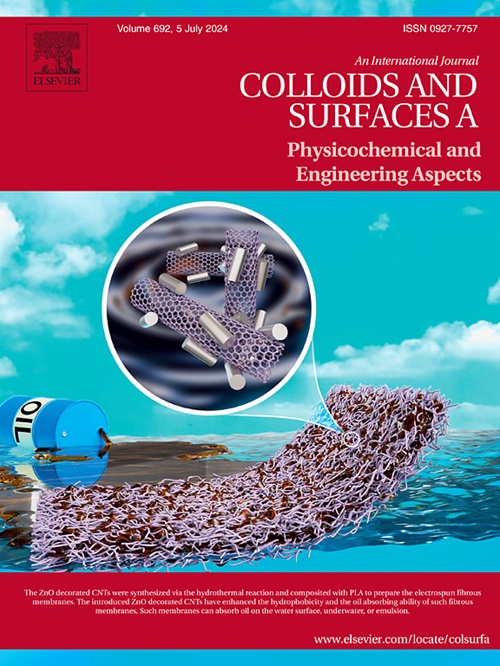谷蛋白-单宁酸纳米颗粒改善谷蛋白乳液贮存不稳定性的机理:基于相互作用、纳米颗粒性质和界面性质
IF 4.9
2区 化学
Q2 CHEMISTRY, PHYSICAL
Colloids and Surfaces A: Physicochemical and Engineering Aspects
Pub Date : 2025-05-14
DOI:10.1016/j.colsurfa.2025.137219
引用次数: 0
摘要
谷蛋白的强疏水性限制了其作为食品乳化剂的应用。为了解决这个问题,我们假设亲水单宁酸(TA)可以与谷蛋白相互作用,以提高谷蛋白乳的稳定性。通过相互作用、纳米颗粒特性和界面性质的协同分析,探讨了Gln-TA纳米颗粒改善乳状液稳定性的机理。这些结果表明,Gln-TA纳米颗粒的形成主要由氢键和疏水相互作用驱动。单宁酸的掺入提高了谷蛋白乳的短期和长期稳定性,但其作用和机制存在显著差异。具体来说,Gln-TA纳米颗粒改善乳状液短期稳定性的能力表现出明显的单宁酸浓度依赖性。当单宁酸浓度为24.0 μmol/L时,Gln-TA纳米颗粒粒径最小(247.8 nm),界面层机械强度最高,具有最佳的乳状液短期稳定性。单宁酸浓度为19.2 μmol/L时,Gln-TA纳米颗粒具有较好的两亲性和抗界面变形能力,具有较好的乳化稳定性。该研究将为研究Gln-TA纳米颗粒提高乳剂贮存稳定性的机理提供新的思路,并为开发对人体有益的蛋白质乳化剂奠定理论基础。本文章由计算机程序翻译,如有差异,请以英文原文为准。
The mechanism of glutenin-tannic acid nanoparticles in improving the storage instability of glutenin emulsion: Based on interactions, nanoparticle property, and interface property
The strong hydrophobicity of glutenin (Gln) limits its application as a food emulsifier. To address this, we hypothesized that hydrophilic tannic acid (TA) could interact with glutenin to enhance the stability of glutenin emulsions. The mechanism of Gln-TA nanoparticles in improving emulsion stability was explored through synergistic analysis of interactions, nanoparticle characteristics, and interfacial properties. These results revealed that the formation of Gln-TA nanoparticles was primarily driven by hydrogen bonding and hydrophobic interactions. The incorporation of tannic acid enhanced both the short-term and long-term stability of glutenin emulsions, though their effects and mechanisms differed significantly. Specifically, the ability of Gln-TA nanoparticles to improve short-term emulsion stability exhibited a distinct tannic acid concentration dependence. When the tannic acid concentration reached 24.0 μmol/L, Gln-TA nanoparticles achieved the smallest particle size (247.8 nm) and the highest mechanical strength of interfacial layers, yielding the optimal short-term emulsion stability. In contrast, Gln-TA nanoparticles at a tannic acid concentration of 19.2 μmol/L exhibited the best long-term emulsion stability, which was attributed to their superior amphiphilicity and interfacial deformation resistance. This study would provide new insights into the mechanism by which Gln-TA nanoparticles enhance emulsion storage stability and establish a theoretical foundation for developing health-beneficial protein emulsifiers.
求助全文
通过发布文献求助,成功后即可免费获取论文全文。
去求助
来源期刊
CiteScore
8.70
自引率
9.60%
发文量
2421
审稿时长
56 days
期刊介绍:
Colloids and Surfaces A: Physicochemical and Engineering Aspects is an international journal devoted to the science underlying applications of colloids and interfacial phenomena.
The journal aims at publishing high quality research papers featuring new materials or new insights into the role of colloid and interface science in (for example) food, energy, minerals processing, pharmaceuticals or the environment.

 求助内容:
求助内容: 应助结果提醒方式:
应助结果提醒方式:


